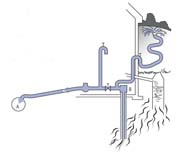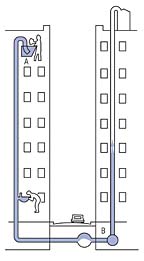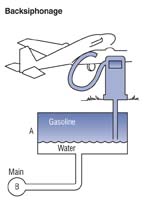Issue: 1/05
Editor's Note: "Back to Basics"
Once we know the hydraulic condition we are trying to prevent and the type of connection involved, we must evaluate the degree of hazard of the unwanted material we are connected to. There are two degrees of hazard to evaluate: low hazard (pollutant) or high hazard (contaminant). A low hazard would be a substance that would be an objectionable substance that could affect the aesthetic conditions of the potable water. The black stagnant water in a wet-charged (nonchemical) fire system would be an example of a low hazard substance.

Now that we have identified the problem, we must look at how we can prevent this unwanted condition from affecting our potable water. This can be achieved by the proper application of various types of backflow preventers. I contend there are five basic means of backflow protection.
I know, I know, I can hear you screaming. You're right, there are many methods, devices and assemblies to use for the purpose of backflow prevention, but if you break them down, they will all fall under one of the five basic means of prevention. These five basic means of protection are: air gap, dual check valve, vacuum breaker, double check valve assembly and reduced pressure principle backflow prevention assembly. For those that will insist, there is the barometric loop. The barometric loop is a continuous section of the supply line that rises a minimum of 35' at sea level, above the highest point of the water used downstream, and returns back to the original level. The barometric loop works on the principle that a vacuum can only draw a head of water so far up a water column, and if the column is tall enough, a backsiphonage cannot draw the unwanted material back into the potable water.

A dual check valve is a device with two independent operating spring-loaded checks enclosed in the same body. A vented dual check is a variety of a dual check that has an atmospheric vent separating the checks. They are used for low hazard only, and protect against both backsiphonage and backpressure.
Vacuum breakers come in all shape and sizes. There are pipe atmospheric, pressure, hose bibb, laboratory, spill resistance and more. You will need to study the exact application requirements and installation criteria for each type. All have these common traits: they protect against low and high hazards, and are used to protect against backsiphonage only. Some vacuum breakers are assemblies and are testable, such as the pressure vacuum breaker.
The double check valve assembly is an assembly consisting of two independently operating internally loaded check valves with tightly closing shut-off valves on each side inlet and outlet, as well as tests cocks properly located for testing each of the check valves. This assembly protects against low hazards only, and both backpressure and backsiphonage.


To help in the selection and designing of backflow protection, ask yourself these 12 questions:
- 1. Is the application a low or high hazard?
2. Is the application subject to backpressure and/or backsiphonage?
3. Is there a danger of water damage?
4. Is the application subject to freezing?
5. Does the application require continuous service?
6. Will there be control valves downstream of the device?
7. Is there electrical equipment located near the installation?
8. Is there sufficient drainage for the application?
9. What will the pressure loss be through the device?
10. Is the device to be used at the point of use?
11. Is there acceptable room for maintenance and testing?
12. Can a remote location be utilized?
These are the fundamentals of good design and engineering criteria and are based on my experience in the design, engineering and providing of backflow protection in potable water systems. There is no "Backflow 101"